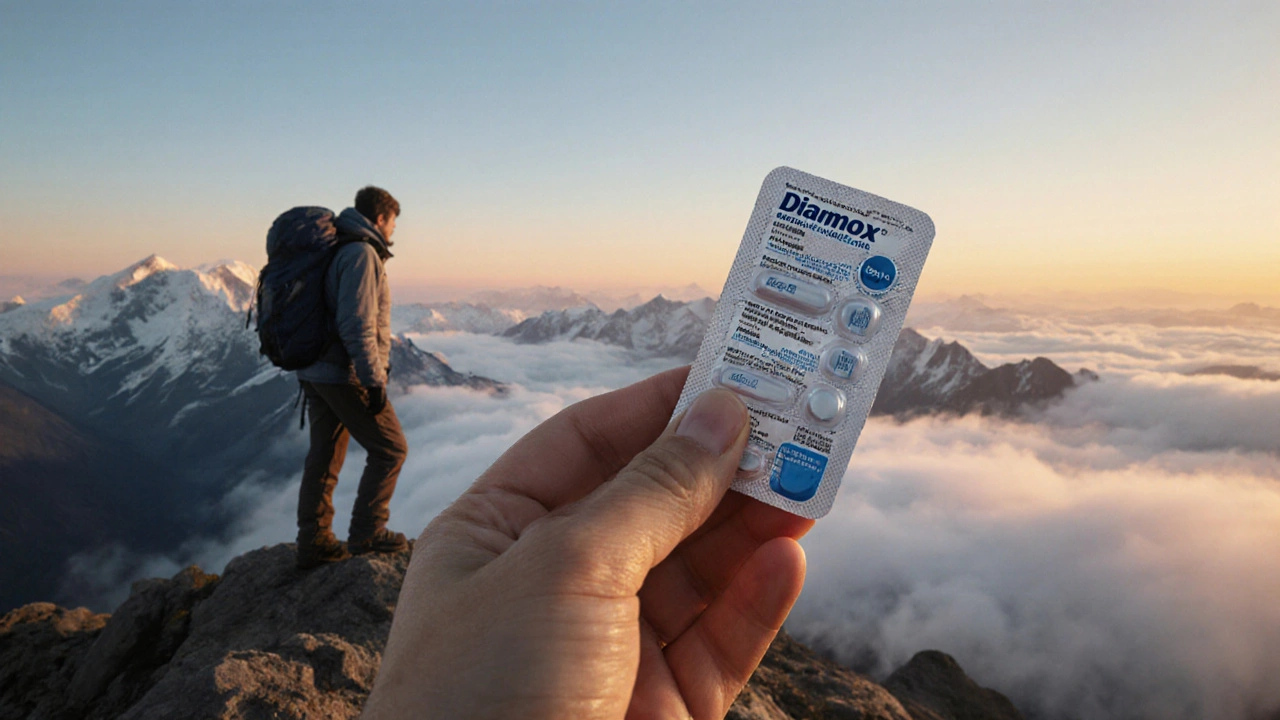Medication Decision Guide
Select Your Condition
Have You Been Diagnosed With Sulfa Allergy?
Are You Cost-Sensitive?
Your Recommended Medication
- Diamox is a carbonic anhydrase inhibitor used for altitude sickness, glaucoma, and certain seizures.
- Key alternatives include methazolamide, topiramate, dorzolamide, brinzolamide, and hydrochlorothiazide.
- Compare efficacy, side‑effects, dosing speed, cost and availability in one handy table.
- Use the decision guide to match the right drug to your condition and lifestyle.
- Talk to your clinician with clear facts - no guessing.
When doctors prescribe a medication, patients often wonder whether there’s a better option on the shelf. That’s exactly the dilemma many face with Diamox is the brand name for acetazolamide, a carbonic anhydrase inhibitor that lowers fluid pressure in the eye, reduces brain swelling, and speeds up acclimatization to high altitude. The drug works well, but it isn’t the only player in the game. Below you’ll find a plain‑English rundown of what Diamox does, who else can do the same job, and how they stack up on the things that matter most - effectiveness, safety, price and convenience.
How Diamox Works and When It’s Used
Acetazolamide blocks the enzyme carbonic anhydrase, which normally helps the kidneys re‑absorb bicarbonate. By inhibiting this enzyme, the drug causes a mild metabolic acidosis that drives the body to increase breathing rate and excrete excess fluid. The result is lower intra‑ocular pressure (helpful for glaucoma), reduced cerebral edema (helpful after surgery or in seizures), and faster adaptation to low‑oxygen environments (altitude sickness).
Typical adult dosing for altitude prevention is 125‑250mg every 12hours, started one day before ascent. For glaucoma, the dose is often 250‑500mg daily in divided doses. In epilepsy, it’s used as an adjunct at 250‑500mg three times a day.
Common side‑effects include tingling in the fingers and toes (paresthesia), increased urination, metallic taste, and occasional mild headache. Most people tolerate it, but a small fraction develop severe electrolyte disturbances or allergic skin reactions. Cost‑wise, a month’s supply of generic acetazolamide in Australia runs around AU$15‑20, making it one of the cheaper prescription options.
Major Alternatives - What They Are and Who Uses Them
Below are the most frequently mentioned substitutes. Each entry includes a brief definition with schema markup - just like we did for Diamox - so search engines can easily map the relationships.
Methazolamide is another carbonic anhydrase inhibitor, chemically similar to acetazolamide but with a longer half‑life, often prescribed for glaucoma and altitude sickness when a once‑daily schedule is preferred.
Topiramate is an anticonvulsant that also inhibits carbonic anhydrase, making it useful for migraine prophylaxis, certain seizure disorders and off‑label for weight loss.
Dorzolamide is a topical eye drop formulation that directly reduces intra‑ocular pressure, commonly used in chronic glaucoma alongside oral agents.
Brinzolamide is another topical carbonic anhydrase inhibitor eye drop, similar to dorzolamide but formulated as a suspension for patients who experience irritation with drops.
Hydrochlorothiazide is a thiazide diuretic that reduces fluid buildup by a different mechanism; it’s sometimes added to glaucoma regimens when additional pressure‑lowering is needed.
Side‑by‑Side Comparison Table
| Drug | Primary Indications | Mechanism | Typical Dose | Onset (Days) | Common Side‑effects | Approx. Cost (AU$/month) | Prescription Status |
|---|---|---|---|---|---|---|---|
| Diamox (Acetazolamide) | Altitude sickness, open‑angle glaucoma, epilepsy adjunct | Carbonic anhydrase inhibition (systemic) | 125‑250mg PO q12h | 1‑2 | Paresthesia, polyuria, taste change | 15‑20 | Prescription |
| Methazolamide | Glaucoma, altitude sickness | Carbonic anhydrase inhibition (systemic) | 50‑200mg PO q24h | 1‑2 | Fatigue, nausea, rash | 20‑30 | Prescription |
| Topiramate | Seizures, migraine prophylaxis, weight loss | Carbonic anhydrase inhibition + sodium channel block | 25‑100mg PO qD (titrated) | 3‑5 | Cognitive slowing, kidney stones, paraesthesia | 30‑45 | Prescription |
| Dorzolamide (eye drops) | Open‑angle glaucoma, ocular hypertension | Local carbonic anhydrase inhibition | 1‑2 drops per eye BID | 1‑3 | Burning, bitter taste | 25‑35 (bottle) | Prescription |
| Brinzolamide (eye drops) | Chronic glaucoma, ocular hypertension | Local carbonic anhydrase inhibition (suspension) | 1‑2 drops per eye BID | 1‑3 | Blurred vision, foreign‑body sensation | 30‑40 (bottle) | Prescription |
| Hydrochlorothiazide | Edema, hypertension, adjunct glaucoma therapy | Thiazide diuretic - reduces NaCl re‑absorption | 12.5‑50mg PO qD | 2‑4 | Hypokalemia, hyperuricemia, photosensitivity | 10‑15 | Prescription |

Pros and Cons - Quick Reference
- Diamox:
- Pros - inexpensive, works for several conditions, well‑studied for altitude.
- Cons - systemic side‑effects, needs twice‑daily dosing, not ideal for patients with sulfa allergy.
- Methazolamide:
- Pros - once‑daily dosing, longer half‑life means steadier blood levels.
- Cons - slightly higher cost, higher risk of skin reactions.
- Topiramate:
- Pros - treats seizures and migraines, beneficial weight‑loss side‑effect for some.
- Cons - cognitive slowing, kidney stone risk, slower onset for altitude.
- Dorzolamide & Brinzolamide (eye drops):
- Pros - target the eye directly, minimal systemic exposure.
- Cons - require proper eye‑drop technique, may cause local irritation.
- Hydrochlorothiazide:
- Pros - cheap, useful if fluid overload is also a concern.
- Cons - unrelated mechanism, can affect electrolytes, not primary glaucoma therapy.
Decision Guide - Which Drug Fits Your Situation?
- Altitude travel: If you need a quick, proven solution and have no sulfa allergy, Diamox 125mg twice daily is the gold standard. Choose methazolamide only if you struggle with twice‑daily dosing and can afford the extra cost.
- Glaucoma management: For most patients, a combination of topical dorzolamide (or brinzolamide if irritation occurs) plus a prostaglandin analogue works best. Reserve oral Diamox or methazolamide for acute pressure spikes.
- Seizure disorders: Topiramate is the preferred adjunct because it addresses the seizure pathway directly. Diamox may be added only when another carbonic anhydrase inhibitor is needed for metabolic reasons.
- Patients with sulfa allergy: Avoid Diamox and methazolamide. Opt for topical dorzolamide (which is also a sulfonamide but has a far lower systemic absorption) or consider non‑carbonic anhydrase agents like prostaglandin analogues for glaucoma.
- Cost‑sensitive scenarios: Diamox and hydrochlorothiazide are the cheapest. If you need eye‑specific therapy, generic dorzolamide offers a middle ground.
Whatever you pick, the key is close monitoring. Check electrolytes after a week on any systemic carbonic anhydrase inhibitor, and report persistent tingling or severe fatigue to your doctor.
Practical Tips for Talking to Your Clinician
- Bring a list of all current meds - including over‑the‑counter supplements - because many contain sulfa.
- Ask about baseline kidney function and blood gas levels before starting.
- Request a follow‑up lab test after 7‑10 days if you’ll be on a systemic agent.
- If you’re traveling, ask whether you need a prescription before crossing borders; some countries restrict carbonic anhydrase inhibitors.
- Clarify whether you need a rescue plan (e.g., oral Diamox) in case your primary eye‑drop regimen fails.
Next Steps & Troubleshooting
If you’ve started a medication and notice any of the following, act fast:
- Severe nausea, vomiting, or dehydration - could signal a metabolic alkalosis; stop the drug and seek medical advice.
- Sudden vision loss - treat as an ophthalmic emergency; contact an eye specialist immediately.
- Persistent tingling beyond two weeks - ask your doctor about dose reduction or switching to methazolamide.
- Allergic rash or swelling - discontinue immediately; it may be a sulfa reaction.
In most cases, a simple dose adjustment or a switch to a topical agent resolves the problem.

Frequently Asked Questions
Can I use Diamox for short‑term altitude trips?
Yes. A typical regimen is 125mg twice daily starting 24hours before ascent and continuing for 48hours at altitude. It shortens the onset of acute mountain sickness in most travelers.
Is methazolamide safer for people with kidney problems?
Methazolamide is cleared similarly to acetazolamide, so dose adjustments are still required in impaired renal function. It isn’t inherently safer; consult your nephrologist before using any carbonic anhydrase inhibitor.
Do topical dorzolamide drops cause systemic side‑effects?
Systemic absorption is minimal, so the classic tingling or metabolic changes seen with oral agents are rare. Local irritation is the most common complaint.
Why does topiramate cause kidney stones?
Topiramate creates a mild alkaline urine environment, which encourages calcium phosphate stone formation. Staying well‑hydrated and monitoring urine pH can reduce the risk.
Can I combine Diamox with a thiazide diuretic for glaucoma?
Combining them is common when intra‑ocular pressure is hard to control. The thiazide helps remove excess fluid, while Diamox lowers pressure via a different pathway. Watch electrolytes closely.







Hannah M
September 30, 2025 AT 19:33Wow, this guide is super helpful 😊 I love how the table breaks down each drug so clearly and the cost info is a lifesaver for anyone on a budget. The altitude section especially caught my eye – I’ve been planning a trek and wasn’t sure which med to pack.
Yareli Gonzalez
October 4, 2025 AT 06:53Great summary, very easy to follow. The step‑by‑step decision guide will make doctor visits smoother.
Carl Mitchel
October 7, 2025 AT 18:13While the article is thorough, it skirts around the ethical concerns of prescribing sulfa drugs to patients with undocumented allergies. A responsible clinician should prioritize patient safety over cost.
Josh SEBRING
October 11, 2025 AT 05:33Honestly, I think the whole “cheapest option wins” mantra is outdated – quality of life matters more than a few bucks saved.
Lily Tung
October 14, 2025 AT 16:53The article provides a commendable overview of carbonic anhydrase inhibitors and their alternatives; however, the presentation could benefit from a more rigorous grammatical framework, particularly regarding the consistent use of serial commas which are conspicuously absent throughout the text. Moreover, the inclusion of dosage titration schedules lacks the precision required for clinical decision‑making, as the ranges are presented without context of patient‑specific factors such as renal function or concurrent medications. In addition, the discussion of side‑effects would be enriched by quantifying incidence rates rather than offering vague descriptors like “common” or “rare.” The cost comparison, while useful, fails to account for regional pricing variability and insurance coverage discrepancies. It would also be advantageous to reference peer‑reviewed sources when asserting superiority of Diamox for altitude prophylaxis. Finally, the visual hierarchy of the table could be optimized by aligning numeric data to the right to facilitate quicker scanning. Overall, the guide succeeds in its intent to educate a lay audience but falls short of the scholarly standards one might expect from a professional medical briefing.
Taryn Bader
October 18, 2025 AT 04:13Who even needs eye drops when the water’s fine?
Myra Aguirre
October 21, 2025 AT 15:33Interesting read. I appreciate the clear layout and the practical tips for talking to a clinician.
Shawn Towner
October 25, 2025 AT 02:53Sure, but have you considered that topical agents might cause more irritation than a simple oral tablet?
Ujjwal prakash
October 28, 2025 AT 13:13Great effort! The guide is thorough-yet, I think the author could have highlighted the importance of renal function monitoring a bit more; otherwise, everything looks fine.
Diane Helene Lalande
November 1, 2025 AT 00:33The section on electrolyte monitoring is especially useful; many people overlook that after starting a carbonic anhydrase inhibitor.
Edwin Levita
November 4, 2025 AT 11:53While Lily’s extensive critique is appreciated, the sheer length makes it daunting for a typical reader; brevity could improve accessibility.
Xander Laframboise
November 7, 2025 AT 23:13Actually, the claim that methazolamide is merely a “once‑daily” alternative is misleading; its half‑life still requires monitoring similar to acetazolamide.
Jason Petersen
November 11, 2025 AT 10:33Nice guide but could use more data on long‑term safety.
Melissa Gerard
November 14, 2025 AT 21:53Honestly, this feels like a sales pitch for cheap meds 🙄 Not all that useful.
Cindy Knox
November 18, 2025 AT 09:13I really appreciate the balanced tone; it makes choosing a medication feel less overwhelming.
beverly judge
November 21, 2025 AT 20:33Your point about monitoring electrolytes is spot‑on; I’d add that patients with pre‑existing kidney issues should have baseline labs before starting.
Capt Jack Sparrow
November 25, 2025 AT 07:53From a pharmacological standpoint, topiramate’s dual mechanism makes it a strong candidate for patients needing both seizure control and altitude prophylaxis.
Manju priya
November 27, 2025 AT 15:26Dear readers, please ensure you consult your physician before making any changes; adherence to professional advice is paramount 😊
Jesse Groenendaal
November 27, 2025 AT 17:40It’s irresponsible to downplay the risks of systemic carbonic anhydrase inhibitors; patient safety should be the priority.
Persephone McNair
November 27, 2025 AT 18:33From a clinical informatics perspective, integrating this decision matrix into EMR systems could streamline prescribing workflows.